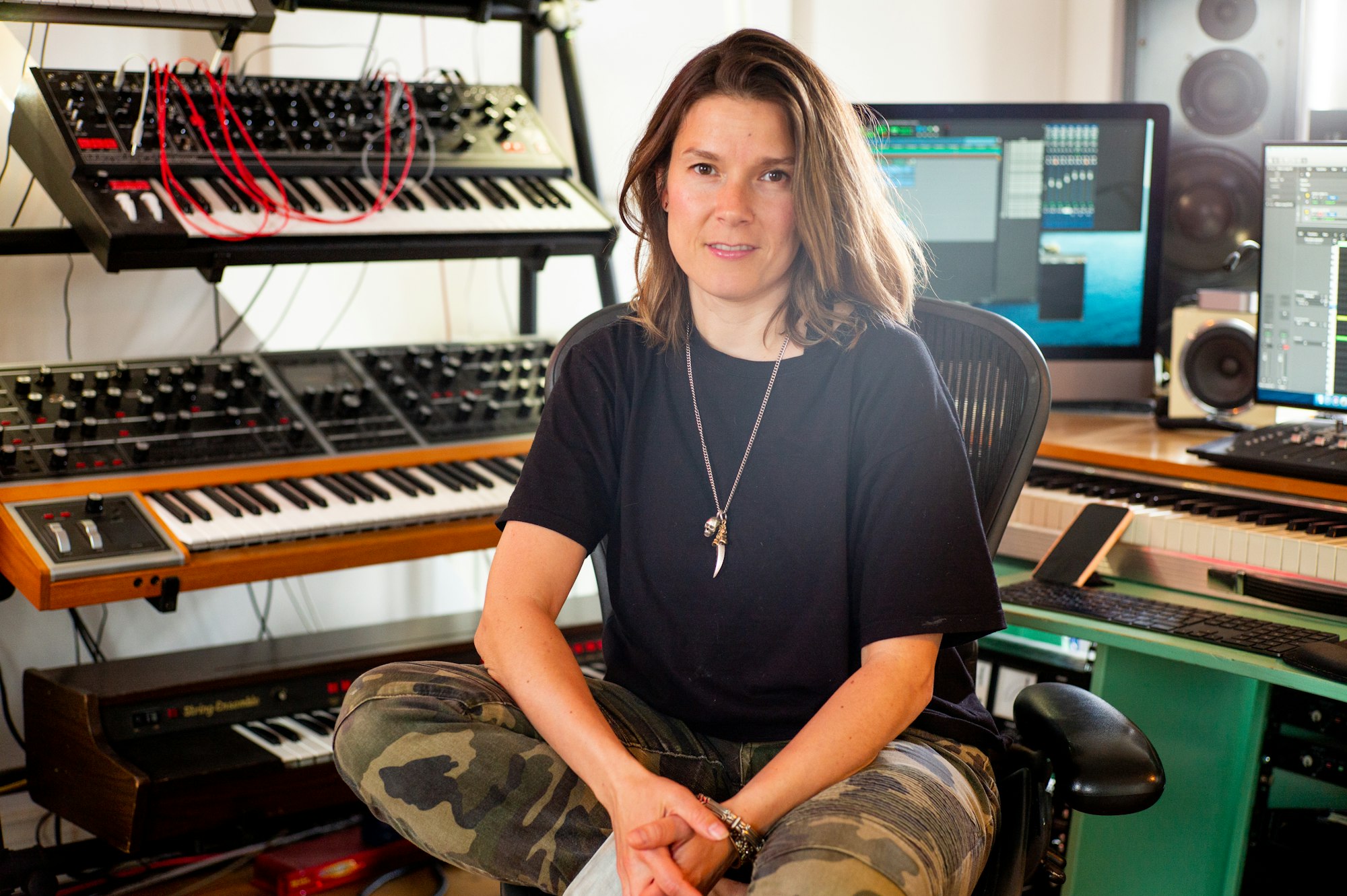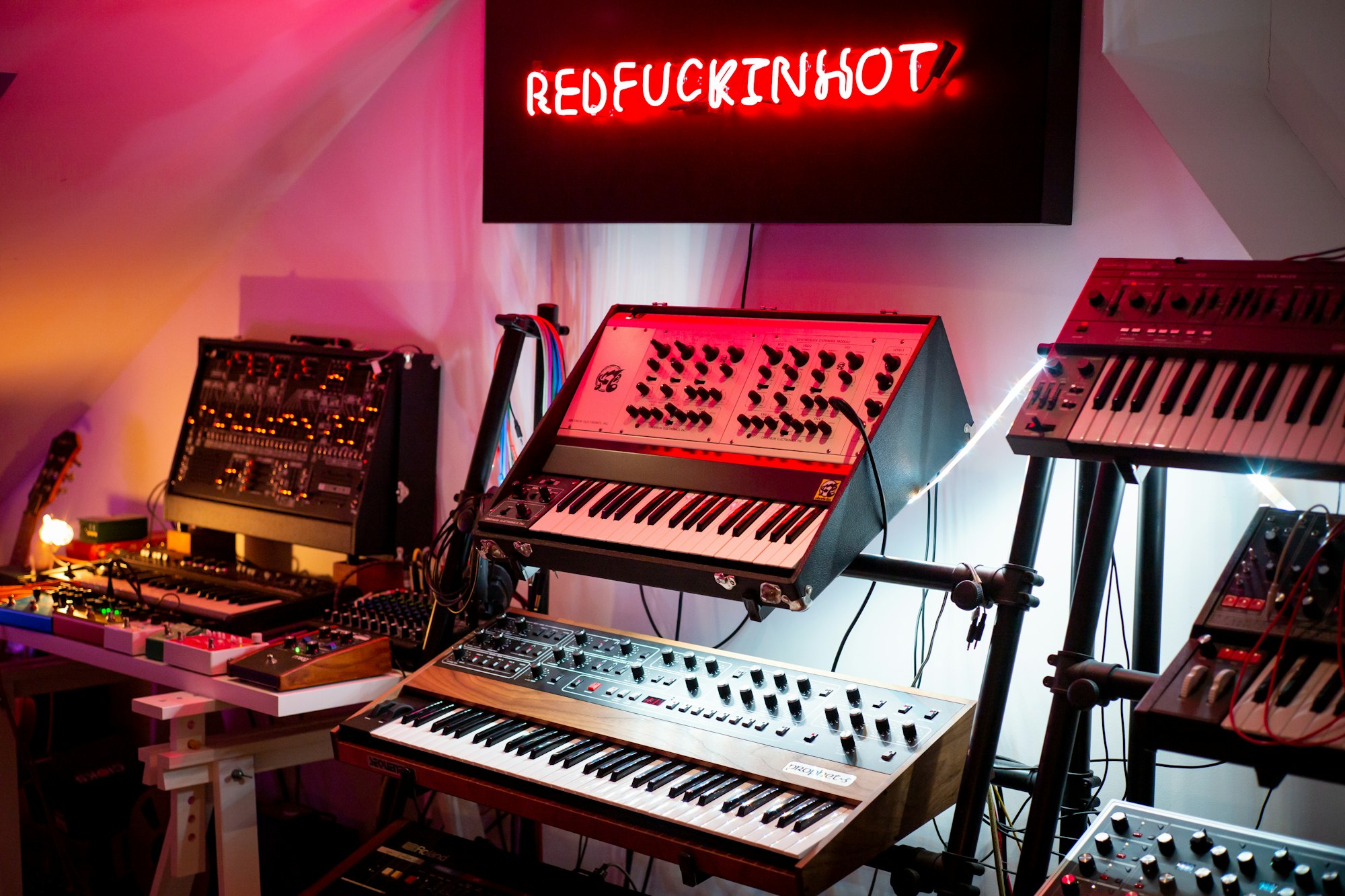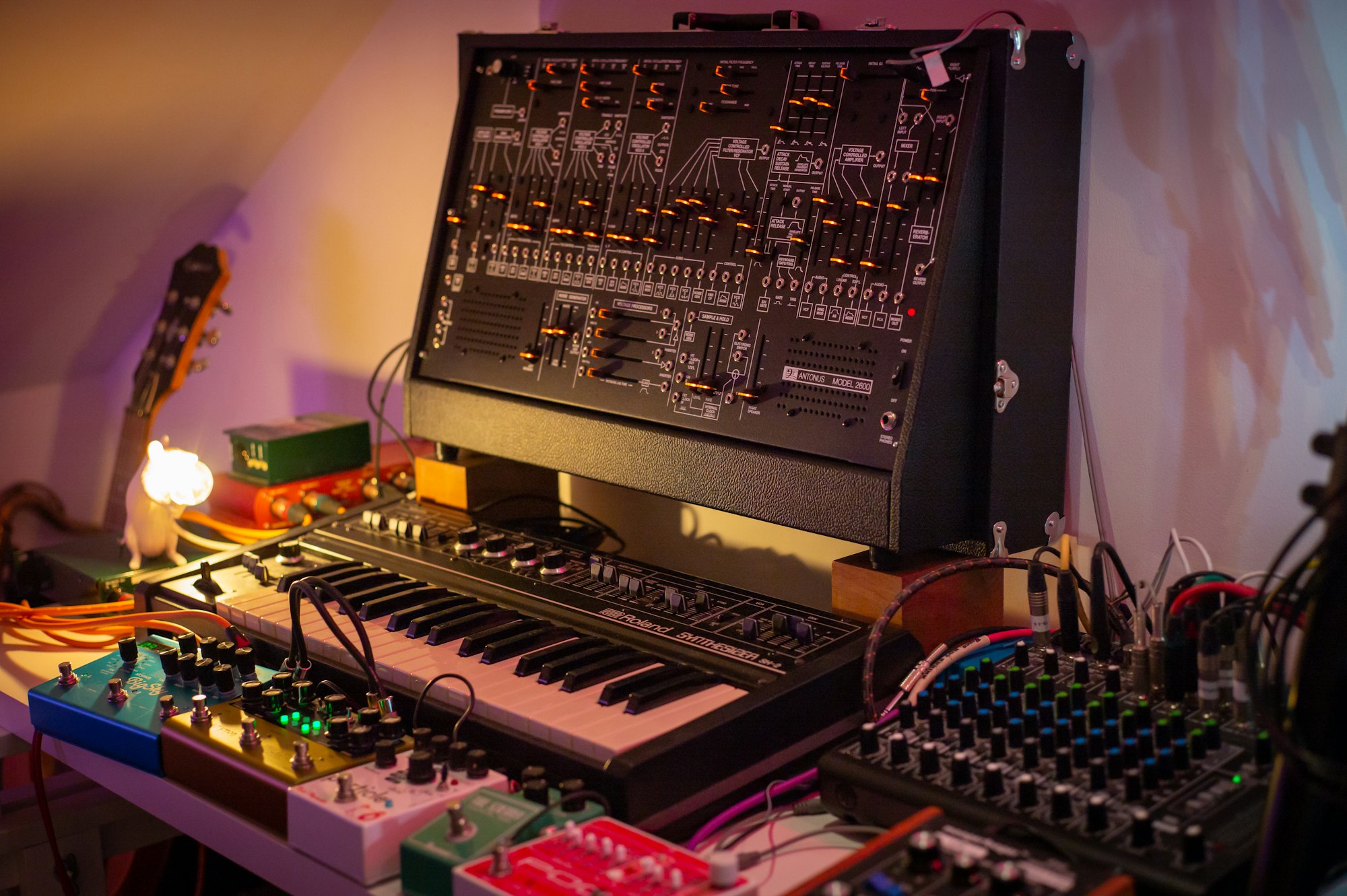Words by Sean Wilson
Composer Ruth Barrett knows a thing or two about crafting soundscapes for television. She collaborated with Line of Duty creator Jed Mercurio for his acclaimed 2018 series Bodyguard and has since experimented with prickly, unusual, and fascinating effects in a host of other shows.
Ruth has now made her first foray into American network TV with Law and Order: Organized Crime. So how does she get beneath the skin of a character-driven drama that plays out over several episodes? And what are the specific techniques deployed to give each show its residual character?
“I can't watch anything without being aware of the music,” Ruth says. “But I really enjoy that part of it. I've been influenced by watching films and listening to music. Growing up with horror films like A Nightmare on Elm Street that I shouldn't have watched when I was a kid. They probably got into my head, actually. I like those soundtracks from the 1980s era because there's this low-fi aspect to them as well. Quite a raw sound. Nowadays, things can be quite polished. I really love the rawness of stuff and that's what I want to put into my scores.”
“I love John Carpenter's scores for the same reason. They're quite low-fi and melodically lean. These gnarly sounds and synthy, eighties propulsive rhythms that I really like. I find that quite sexy. I like languorous music too, but there's a driven quality to Carpenter's music. It draws you in.”
“I love classical, and contemporary classical music too. Things like Stravinsky and Shostakovich. I love weird, experimental stuff. The Shining is perfect for that. Hearing Wendy Carlos's opening for that film – it's mesmerising. Those electronic sounds are something that I find incredibly eerie. I love the idea of using an organic source like an instrument and getting someone to go out of their comfort zone with it. I like to then take that sound, process it, stretch it, or play with it, and then use that as a source, rather than using samples. I like to use my own sounds.”

Ruth’s latest project, Law and Order: Organized Crime, sees the return of Stabler (Chris Meloni) to the series after an absence of more than 10 years. Ruth laughs when detailing the pressures of writing music for American network TV.
“I did the groundwork, the thematic material, bashed out some pieces and they responded well to those,” she recalls. “Then it was a case of putting it to picture! We've got a two-week break now because they took it off-air, due to COVID. It's like a breather before the next four episodes go out. Because of the enthusiasm of the creatives, it pushes you to do things you didn't think you could do. They asked me to do the dance and said that they believed in me. Game on! Owing to COVID, I've got musicians working all over the place. I've got two of them in Scotland, one's in Spain – no-one's coming over to our studio at the moment. They're recording it in their own locations and sending it in. Then we put it all together.”
I love weird, experimental stuff. The Shining is perfect for that. Hearing Wendy Carlos's opening for that film – it's mesmerising.
The scope of the project, with its clear good guy/bad guy axis, allowed Ruth to indulge her love for eccentric sounds. In this instance, the music comes with an unexpected cultural twinge.
“I've always liked Westerns, and that whole philosophy, 'This town ain't big enough for the both of us’”, she says. “I was thinking about Stabler and his life, and the fact that he'd been living in Italy for 10 years. And some of the gangsters are New York Italians. I thought that, OK, maybe there are some Italian flavours in there.
“I was telling the production team early on that I intended to use some Italian flavours like, maybe, mandolin for Stabler. There's energy in the music and this guy is bristling with energy. He's not a depressive guy. He's really angry and he flies by the seat of his pants. He crosses the line a lot. So the mandolin is cool for that, maybe not an Italian tremolo type of thing, but if it's playing a rhythm part, it's got a lot of bite to it.
“For the bad guy, I was interested in exploring opera. That's the only point where the team stepped in and said, 'You know, they're not actually Italians, they're not from The Godfather. So I acknowledged that. I looked for a little bit of [opera composer] Pergolesi and looked for just a few bars that I could use as a starting point. It has a flavour of the family. This sense of, 'This shit's been going on for centuries, and it all roots back to the family.' It's quite a baroque piece and has quite a lot of emotion to it. The chord sequence is almost familiar to us. It's quite a nice basis to use.”

Ruth is palpably gleeful when revealing her next steps. “I then gave it some really horrible sounds. Some disgusting synth noises that make this guy really nasty at his core. You've got this beautiful chord structure and then, underneath, is this disgusting cesspit of synth sounds or cello flavours, bows splitting in two. Ultimately, his soul is dirty, he's damaged and broken.”
This desire to mess with the orthodox and the conventional has swiftly become a hallmark of Ruth’s compositional career. Of course, one also needs consistent and reliable collaborators to exercise those muscles. Fortunately, she found a kindred spirit in the form of ex-doctor turned TV showrunner Jed Mercurio (Line of Duty), with whom she first worked on the 2015 medical series Critical.
“It was beyond a documentary,” she recalls of the series, which was cancelled after just one season. “It was a medical drama. But the music could be really dramatic, tense, fast BPMs, racing along with this wave of energy and stress. In one scene, they managed to sew up a hole in the heart and I made this emotional music come out of it. They saved the day and this wash of emotion comes out of it. That was an amazing thing to score. Nobody knew what temp to put on it or how to even score the show. One had to hold the viewers on a rollercoaster, almost, alongside the medical team.
“Jed loves to go to the extreme and if there's noise, he wants more of it. Not in a melodramatic way, but in those situations, it's a real feeling. It's not telling people to be scared. It's in the drama. Jed is someone who wants you to put your foot down on the accelerator and go full-throttle. In Critical, there was an alarm sound that the team was working on. Jed then said, 'You know the alarm in Alien? I want it like that.' And they pointed out that no-one talks as much in Alien, and we have to have this dialogue.”
The two later came together for the riveting 2018 thriller series Bodyguard. The show’s relentless air of paranoia, sense of topicality, and gritty performances (namely from stars Richard Madden and Keeley Hawes) saw it graced with critical acclaim. Once again, Ruth praises Mercurio’s enthusiasm for pushing the boundaries, as music and sound blur inexorably.
“We definitely did that in Bodyguard,” she explains. “Specifically, the fight or flight reaction. Jed Mercurio called it 'the reptilian brain'. I remember playing him the first sequence of Bodyguard when they're on the train. I thought that sequence was already amazingly tense without any music on it at all. It was in its early stages. They'd lost a location and had to reshoot, so it was quite last-minute in a train carriage in East Anglia. The whole sequence had to be completely changed from the first concept, which was in Waterloo. But because of that, it's got this claustrophobic feeling.
One characteristic of Ruth’s personality is her wicked sense of humour. She more than recognises the enjoyable absurdity of recording the score for the ghost story series Remember Me (2014) in Chislehurst Caves. She recalls: “I hadn't thought of much music but I had a folk song. I had some ideas about a sound because it was a ghost of a person who had been drowned. So watery and creepy sounds. She was an Indian ghost as well, so I had this amazing Indian percussionist and he had loads of other instruments. We used a lot of that and went into the caves, recording ourselves moving around this space with loads of equipment.” Laughing, she adds: “It was very cold and we did get lost a couple of times – it was very dark down there.”
You're not just pleasing the director. You've also got to please yourself as well. It can't just be a case of copying or music by numbers.
Ruth’s career is a testament to modesty and ingenuity. When discussing the early origins of her production studio Rubykon, established with her now-husband, Ruskin, she recalls a period in which she was making adverts, despite possessing “no equipment, just a Clavinova and a piece of the manuscript. That's how I did my first demos”. When she first met synth musician Ruskin, they started working on adverts and, later, documentaries.
At the time, Ruth says she was working at ITV post-production as “a day job”. What happened next changed her career trajectory forever. “I met people, got to do a South Bank show, and from that, other documentaries. I then left ITV and went to work for Strong Room Recording Studios, which was a rock and roll studio. I knew a lot about post-production sound in general from my ITV days so I went to Strong Room to help them set up a post-production department.
“During that time, I also thought about getting composers to mix their music at the studios. Martin Phipps was one of the composers I brought in. That's how we met. I got to know his music and he got to know mine. He was a writer for drama and films, and he invited me to one of his sessions. It was North and South, I think. At that moment, I thought, 'This is it. This is what I want to do.' Just seeing the orchestra playing and seeing the visuals going with it – I could feel the emotion in the music. Not that documentary is lesser, but I really felt the calling to doing long-form drama. Adverts were really hard to do and quite irritating. I pestered Martin, sent him my music and he then suggested that I do a scene. He gave me a few scenes to do and it developed from there by ghost-writing. He then helped me to get my own jobs.”
As with every film and TV composer, the nature of collaboration is perhaps the most important factor. “Some directors are very specific about what they want,” she says. “They might have a temp score that they want you to draw from. Some directors have already scored the project, quite specifically, with a temp score because they like to cut with music. And if you haven't written the music in time, you end up with this other score on there that the director then finds hard to throw away. I have to find something in it for myself that resonates in terms of the characters and story. You're not just pleasing the director. You've also got to please yourself as well. It can't just be a case of copying or music by numbers."
“I don't think any director truly wants that, even if they're wedded to their temp score. However, they are the director, it's their vision, and let's work with it. So it's a case of what I can bring to the table. What haven't they thought of that I can put in there? What can add something unexpected? It might be a bagpipe or something. I'm into the extremes of instruments, and what you can do with musicians to make them break their instruments. Many directors feel the need to be controlling to convey what it is that they want. They don't feel comfortable talking about ideas because maybe you'll go off on a tangent and it'll be total rubbish. A starting point should only be seen as thus because otherwise, you're just a hack. You're not digging into the story or thinking about what the palette should be.”

Ruth’s maverick desire to pursue her own voice has elicited a whole host of singular projects. Despite the collaborative nature of the scoring medium, she says it’s critical for individual artists not to compromise on their vision.
“Every composer brings their own identity to the table,” Ruth says of the process. “It's a collaboration but, ultimately, you have to have your own take on the material. It's your instincts that are really important in this job. What do you feel when you're watching a scene? What needs to come out in the music? And there's that little thrill when the music hits the spot: 'I feel something, so hopefully, somebody else will.’”
Concluding our talk, she alludes to a “new show”, the title of which she cannot reveal. Nevertheless, Ruth is visibly excited at the opportunities it provides.
“The director's a Hollywood director,” she explains. “We had a great chat and I've seen his films. They're action films but I felt there was humanity and character in there. There's this other layer of depth. That's the kind of film I like to watch. I said that, on the basis, 'I feel like I can get on with you.' The director responded and said that he felt my personality came through the music. That's the place you want to start from: a synergy, a creative locking of tastes and feelings. Inevitably, you don't get on with everybody, but when you find the right people, then that's when magic's going to happen.”
